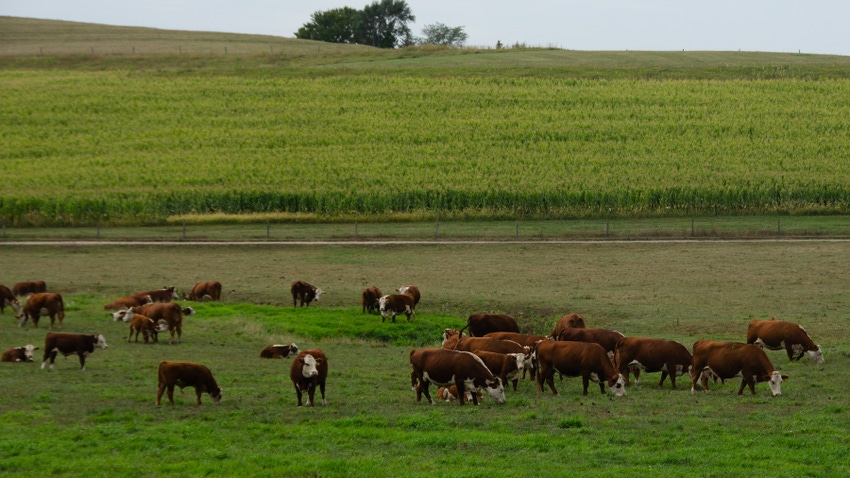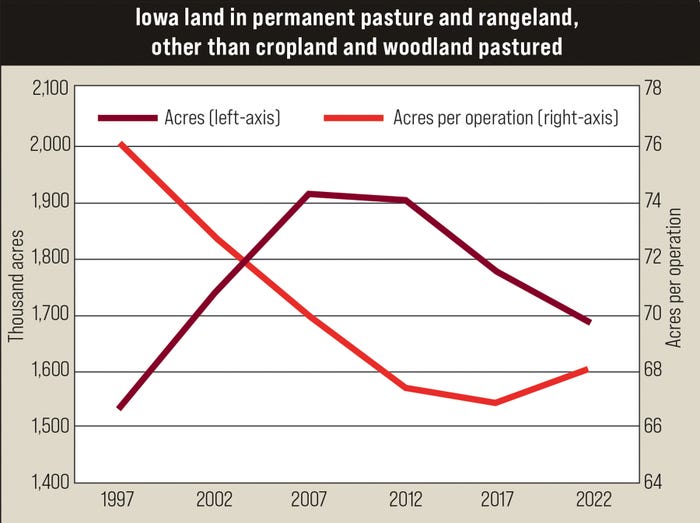March 20, 2024

Cow-calf producers need forage. Cornstalks can supplement forage supplies. Still, pasture and hay are the key forage resources. Growing forages takes land.
Farmland-use decisions involve trade-offs. If you choose to grow hay to earn income from cattle, you give up the opportunity to earn income from growing corn, for example, on that land. “Opportunity cost” is what economists call the loss of potential gain from other alternatives when one alternative is chosen.
Resources such as land, labor, machinery and capital can be employed somewhere else. Thus, all resources have opportunity costs wherever you choose to employ those resources.
How to evaluate resource allocation
The more clearly you can define your opportunities and alternatives, the better you position yourself to more easily evaluate trade-offs. This will help eliminate some alternatives, which will limit those that require number crunching. The thought process may go something like this:
What resources do you have?
What opportunities or alternative ways do you have to use those resources?
What are the advantages and disadvantages of each of those alternatives?
How much income, costs and net earnings would each alternative have?
Explicit opportunity costs are costs that are obvious from choosing one option over another. For example, renting out land or enrolling it in the Conservation Reserve Program to collect a payment forgoes income you could earn by farming the land yourself.
Agricultural production involves a bundle of resources, rather than a single input. Typically, the goal is to maximize the return to the bundle of resources. That complicates calculating opportunity costs for individual resources.
People often more highly value the earnings that can be made today over those in the future. It’s human nature. It’s the tug of immediacy of a promised benefit versus a payoff that’s possibly years down the road. That’s a trade-off.
People may forgo potentially higher returns for other reasons. Some people like to have cows on pasture and realize the environmental benefits of grazing cattle.
An Iowa Beef Center Cow-Calf Producer Survey indicates the four largest competitors for buying or renting pasture or hay acres are:
conversion to row crops
other livestock producers
CRP
recreation
25% of Iowa farms with cattle
The Census of Agriculture is a complete count of U.S. farms and ranches as well as the people who operate them. Even small rural and urban parcels count if they normally produce $1,000 or more of agricultural products per year. USDA released data from the Agriculture Census for 2022 on Feb. 13.
Iowa has a total land area, including non-agricultural land, of 35,747,295 acres. Iowa has 86,911 farms, totaling 29,978,165 acres. The average Iowa farm size is 345 acres. Iowa has 21,750 farms that have cattle, comprising about 9.7 million acres operated or 447 acres per farm.

Many of these farms have both crop and livestock enterprises. To know what business the farms are primarily engaged in, the North American Industry Classification System can be used. Iowa has 8,311 beef cattle ranching and farming operations (think cow-calf) and 1,478 cattle feedlots. Iowa has 1,317,872 acres in beef cattle ranching and farming, averaging 159 acres per farm. There are 788,222 acres in cattle feedlots or 533 acres per farm.
According to an Iowa Beef Center Feedlot Operator Survey, 84.1% of respondents indicated that they produce 50% or more of their feed needs on their own farm. Respondents also reported owning or renting sufficient land to utilize manure produced by their own operation.
Competition for land is intense
Most agricultural land in Iowa — 25,881,597 acres, or 86.3% of the total land in farms — is used to grow crops. Here’s a tally of this cropland:
harvested cropland — 23,520,694 acres
cropland sitting idle, or used for cover crops or soil improvement, but not harvested, pastured or grazed — 2,078,005 acres
pasture and grazing land that could have been used for crops without improvement — 255,065 acres
cropland with failed or abandoned crops — 27,213 acres
summer fallow cropland — 620 acres
Woodland accounts for 1,224,543 acres, or 4.1%, of all agricultural land in Iowa. A majority of this is woodland not pastured at 921,340 acres and woodland pastured at 303,203 acres. Permanent pasture and rangeland, other than cropland and woodland pastured, accounts for 1,687,658 acres, or 5.6%, of all agricultural land in Iowa. Land in farmsteads, homes, buildings, livestock facilities, ponds, roads, wasteland, etc., is 1,184,367 acres, or 4 %, of Iowa’s agricultural land.
In 2022, Iowa had 1,619,175 acres enrolled in CRP, Wetlands Reserve Program, Farmable Wetlands Program or Conservation Reserve Enhancement Program. Operations with land enrolled in these government programs are counted as farms, but the acres are not counted as agricultural land.
Read more about:
FarmlandAbout the Author(s)
You May Also Like






